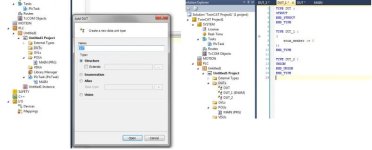Peter Nachtwey
Member
It appears that no one uses the TYPE and END_TYPE to define user defined data types or do enumerations.
I am probably 1/3 done. I can't work on it all the time. Sometimes I must into the field and do training or get distract by business stuff.
It kind of cool how a compiler works. It is very recursive as there rules that invoke other rules or rules that invoke themselves. I can see how or why languages were developed early on.
I have the the ST specification. It cost about $250-$300 I think. I have found errors and it isn't complete. Still the person that wrote the specification seemed to know what he was doing as far a defining a compiler.
I am probably 1/3 done. I can't work on it all the time. Sometimes I must into the field and do training or get distract by business stuff.
It kind of cool how a compiler works. It is very recursive as there rules that invoke other rules or rules that invoke themselves. I can see how or why languages were developed early on.
I have the the ST specification. It cost about $250-$300 I think. I have found errors and it isn't complete. Still the person that wrote the specification seemed to know what he was doing as far a defining a compiler.








